Story by Brandes Elitch
Photos by Petya Elitch
If you have never attended the Monterey Car Week then you need to know that there are two basic rules: you can’t see everything, so don’t try, and – as we used to say in the Army – “Move with a purpose.”
There are years when I have skipped the races at Laguna Seca, and I stopped going to Pebble Beach after twenty plus years of regular attendance. But one event I don’t miss is the Concorso Italiano – the largest Italian car show in the world.
Let me point out why this is not happening in Italy.
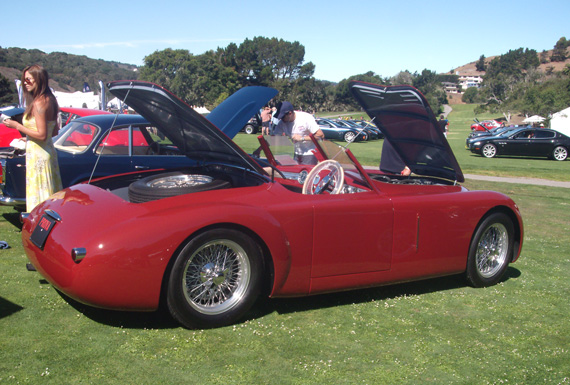
One of the truly spectacular finds of the weekend: a 1948 Alfa Spyder Corsa 6C2300, owned by Ashley Viera of Atlanta, GA.
In addition the annual road tax, something unheard of in the US, has increased by 500 percent in the last few years. Earlier this year, at the Cortina d’Ampezzo ski resort, 251 luxury cars were stopped, and 42 owners had declared an income of less than 30k euros for 2009 and 2010. Tax evasion is estimated to cost Italy about 120 billion euros in lost revenues annually, which explains a lot. So if you want to see a complete historical record of postwar Italian cars, one might go to Monterey, not Italy.
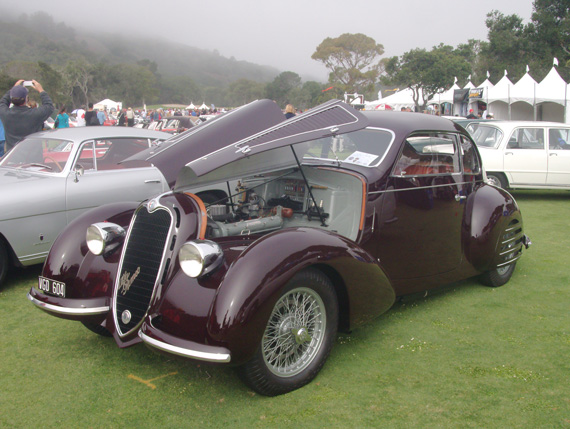
This magnificent object reminds me of a quote from a 1965 article in C&D: 'It is arrogant and self-confident in its refusal to compromise, and if you don't like it, it seems to infer that you are a person lacking taste, virility, and intelligence....' - a 1938 Alfa Romeo 6C2300 with Touring coachwork, owned by Barry Hon of Dana Point, CA.
I attended the original event held at the Carmel Mission Inn, many, many years ago. When it became obvious to the founder, Francis Mandarano, that this had the potential to be a really big show, he moved it to the Quail Lodge grounds, where it prospered for many years, until forced to move. Soon after, the ownership of the event changed as did the venue, and for a while it looked like this event was in a downhill spiral. Then, it was re-invented at a new location, a golf course just a short distance from the Mazda Laguna Seca racetrack, and it has prospered ever since. When you get this many sheer cubic dollars in one place, things can get a little weird. While most people are real enthusiasts, there is the inevitable contingent of Ricky Racers, self-important dweebs, and even some malevolent twerps, but that is to be expected.
_________________
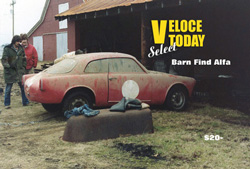 VeloceToday Select Number Two:
VeloceToday Select Number Two:
Barn Find Alfa
Edited by Pete Vack
_________________
The organizer, Tom McDowell, says that “All good Italian events must have a little chaos,” but this event is run with Teutonic efficiency. The layout, placement, choice of vendors and sponsors, awards, features, presentations, and even a fashion show (a Concorso tradition) were faultless. An event this size takes a full year to plan, and that is if you are lucky and don’t have any surprises, and the financing needed to do this requires very careful planning indeed. When I got there at 9 am, all the cars were already in place, an extraordinary logistical task for a show this size. (Did I mention that the traffic on the Monterey Peninsula during the Historics is equivalent to rush hour on a Friday afternoon starting a three day weekend at the Holland Tunnel?)
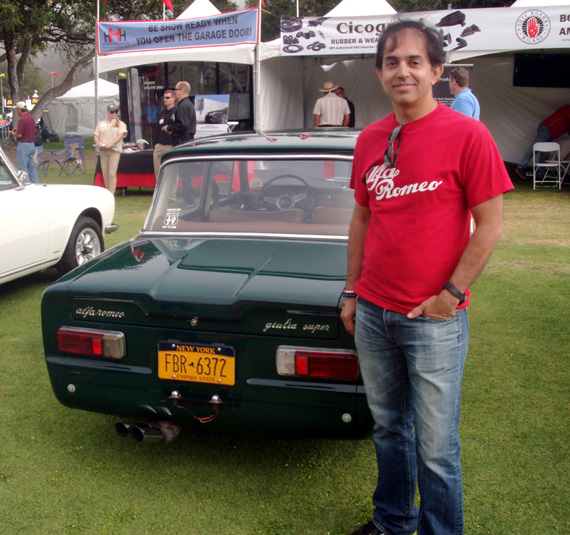
1967 Alfa Giulia Super with owner Baktash Bootorabi, of Fairport, NY, driven across the country for the Alfa National Meet and the Historics.
Imagine a sea of Alfas, Ferraris, and Lamborghinis as far as you can see. Yes, many of the cars are quite similar, but that’s okay if you actually own one of them, as I imagine most attendees do, and there are always the unique, one of a kind things to get your attention. For instance, there was an Alfa Berlina with a decal on the rear window that said: “NY to CA – Alfa Meet 2013.” I spoke to the owner, Baktas Bootorabi, and he mentioned his website: www.route66alfa.com, which you will find interesting. This is a real Alfa person!
Another interesting story concerns the “twice-baked” Lamborghini LP420 Urraco owned by Karlton Spindle. You can find the whole story at: www.facebook.com/lamborghiniLP420SvmUrraco. Originally purchased in 1974, it caught fire and was sold as a parts car by the insurer. Karlton was a high school senior at the time, and he convinced his father to loan him the money to buy and restore the car. The agreement he had with his father was that he would ultimately sell it and use the funds to pay for his college education. He sold it around 1979 to a family friend, who helped with the restoration.
When his father died in 2011, Karlton started searching eBay Motors for Urracos, and he found what he believes was his car, but this time it was again a burned out shell. He decided to build a modern interpretation of the Urraco, using eBay Motors to find the authentic Lambo parts. The crowning touch is that he installed his father’s cuff links in the doors. It is a testament not only to the power of the human spirit, but also to, yes, eBay motors, because without it (or Craigslist) it would have been almost impossible to find the parts to do this.A unique feature of this year’s show was a focus on the Apollo: an Italo-American hybrid that was built from 1963-5 in Turin by Intermeccanica, a firm founded in Italy by Canadian Frank Reisner. The 3 founders, Milt Brown, Ned Davis, and Ron Plescia were motivated by the fact that a Ferrari could win Le Mans, but not survive a 5 pm commute in rush hour traffic without boiling its coolant and fouling its plugs.
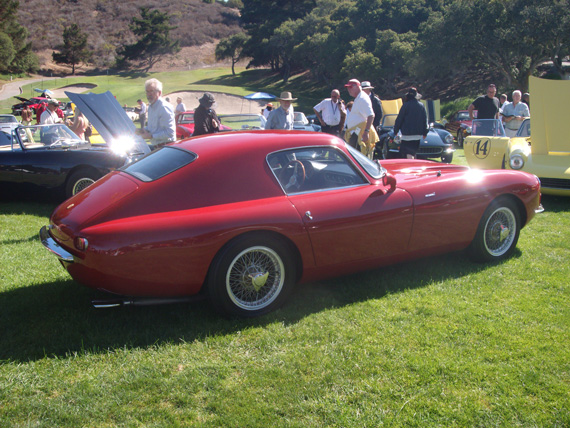
The seventeen Apollos gathered together at the Concorso, including this one-of-a-kind hardtop - a remarkable assembly that must have taken a lot of coordination and cajoling by the organizers.
A beautiful Italian body was equipped with the Buick Special 215 aluminum V8 for motive power. A total of 88 cars were built, about 50 can be traced today, and 17 of them were on the show field at the Concorso, in addition to the original founders, who were interviewed during a special ceremony. Congratulations to the organizers for a splendid presentation here.
The Concorso is divided into sections for each marque, and all the Italian ones are there. There is also a separate parking area for non-Italian cars. There were about fifty vendors located throughout the course. You can count on a minimum of 3 hours to walk it, and that is if you “move with a purpose.” I have to compliment the organizers on the fact that it was pretty easy to drive in and drive out. This is a minor miracle given the traffic on Highway 68, the main road. Leaving the Concorso, you can just turn left, go over Las Laureles Grade Road, make a right turn, and you are only a few minutes from the Quail Lodge show, where you will find the parking and traffic nightmare that you missed at the Concorso. Leaving Quail Lodge, I was surrounded by some of the show cars, including the iconic Corvette Sting Ray prototype, and they all had to shut off their motors to avoid overheating in the traffic.
There was one new event at Monterey this year that I predict will become a regular feature: the Automotive Film Festival, held at the Golden State Theatre in Monterey. This included themes like “Great Road Trips,” “Tribute to John Fitch,” and Le Mans Night.” I didn’t attend this one (no time) but sitting in a movie theatre after a day of walking the track or a car show sounds like a good idea – you wonder why nobody thought of it before.
Finally, just to put the final touch on things, so to speak, on August 14, in addition to the daily mass in the Blessed Sacrament Chapel at the Carmel Mission, there was a different kind of service: a benediction and blessing of the cars, conducted by Bishop Richard Garcia of the Diocese of Monterey. The holy water and holy values will undoubtedly enhance the driving experience of these lucky owners and, who knows, perhaps even be worth an extra point in the judging.
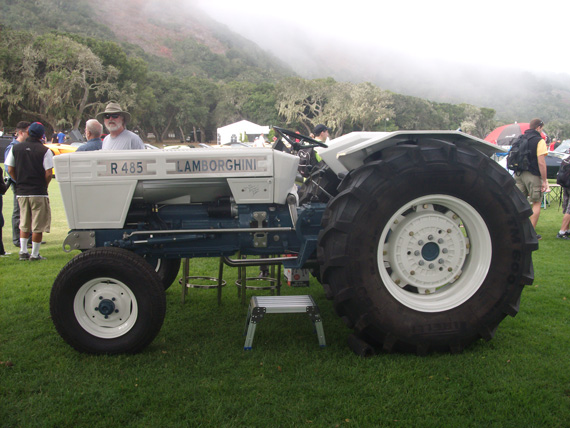
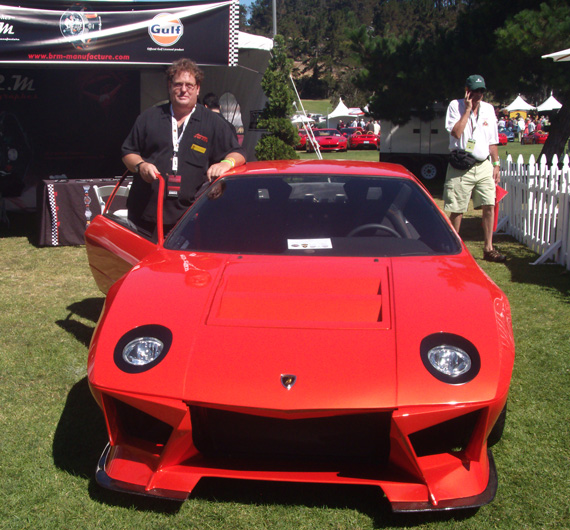

Nice review as usual. Anyone who has attended these events knows how spectacular
they all are and Brandes always manages to find the best of the best. Keep do’in it!
WOW thank you for the very kind words!!!!!!
Having just returned from 4 weeks in Italy, I wondered what the Tax Police cars were all about. I found Italy to be very much a “cash only” society in many places, while at the same time they would complain about the poor financial state of the nation – go figure! 😛
Just a correcton about the Apollo: Only the bodies were built by Intermeccanica. These were hammered out of steel by hand, painted, wired and trimmed, then shipped by boat to Oakland, CA. Your wording implies that Intermeccanica was the constructor.
Actually, Intermeccanica was the coachbuilder (a la Pininfarina). But not the constructor.
Milt Brown’s International Motor Cars assembled the running gear (modified) from the 1962 Buick Special (components literally purchased over-the-counter froma local Buick dealer!) under the bodies in Oakland, doing final testing on the roads outside of that city.
The car was completely designed by Brown (chassis) and Ron Plescia (body) in the US. Franco Scaglione was called in by Frank Reisner to prepare the drawings for production of the body, and it was at this time he tweaked Plescia’s design.
Seemingly small points. But important ones!
Robb Northrup
President, Apollo Owners Registry
I live in Italy now and Italy is a country with dreadful rules, ridiculous regulations, hurtful taxes and hidden social requirements… however none of these ever dull life because everyone lives on the basic assumption that all the rules, regulations, taxes and social requirements are only for everyone else.